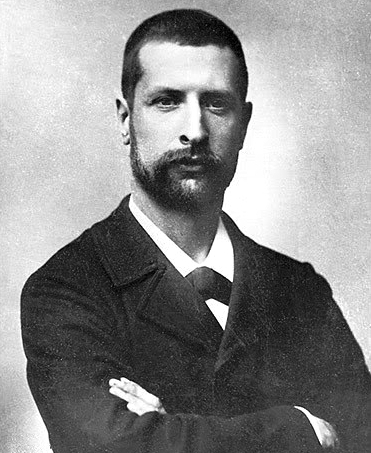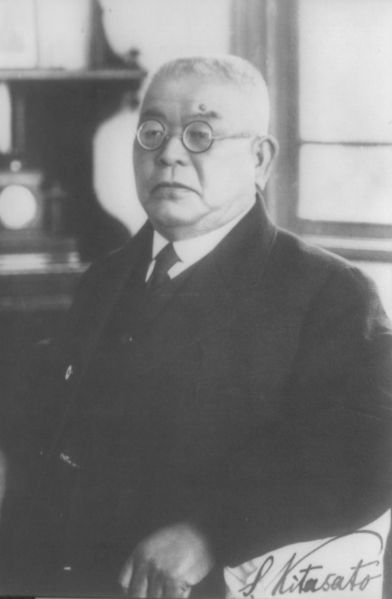<Back to Index>
- Physician and Bacteriologist Alexandre Emile Jean Yersin, 1863
- Physician and Bacteriologist Kitasato Shibasaburō, 1853
PAGE SPONSOR

Alexandre Emile Jean Yersin (September 22, 1863 - March 1, 1943) was a Swiss and French physician and bacteriologist. He is remembered as the co-discoverer of the bacillus responsible for the bubonic plague or pest, which was later renamed in his honor (Yersinia pestis).
Yersin was born in 1863 in Aubonne, Canton of Vaud, Switzerland, to a family originally from France. From 1883 to 1884, Yersin studied medicine at Lausanne, Switzerland; and then at Marburg, Germany and Paris (1884 - 1886). In 1886, he entered Louis Pasteur's research laboratory at the École Normale Supérieure, by invitation of Emile Roux, and participated in the development of the anti - rabies serum. In 1888 he received his doctorate with a dissertation entitled Étude sur le Développement du Tubercule Expérimental and spent two months with Robert Koch in Germany. He joined the recently created Pasteur Institute in 1889 as Roux's collaborator, and discovered with him the diphtheric toxin (produced by the Corynebacterium diphtheriae bacillus).
In order to practice medicine in France, Yersin applied for and obtained French nationality in 1888. Soon afterwards (1890), he left for French Indochina in Southeast Asia as a physician for the Messageries Maritimes company, on the Saigon - Manila line and then on the Saigon - Haiphong line. He participated in one of the Auguste Pavie missions. In 1894 Yersin was sent by request of the French government and the Pasteur Institute to Hong Kong, to investigate the Manchurian Pneumonic Plague epidemic, and there, in a small hut next to the institute (according to Plague by Wendy Orent), he made his greatest discovery, that of the pathogen which causes the disease. Dr. Kitasato Shibasaburō, also in Hong Kong, had identified the same bacterium several days earlier, but because Kitasato's initial reports were vague and somewhat contradictory, some give Yersin sole credit for the discovery; however, a thorough analysis of the morphology of the organism discovered by Kitasato has determined that there is "little doubt that Kitasato did isolate, study, and reasonably characterize the plague bacillus" and "should not be denied this credit". Yersin was also able to demonstrate for the first time that the same bacillus was present in the rodent as well as in the human disease, thus underlining the possible means of transmission. This important discovery was communicated to the French Academy of Sciences in the same year, by his colleague Emile Duclaux, in a classic paper titled La Peste Bubonique A Hong - Kong (Ann. Inst. Pasteur. 8: 662 - 667).
From 1895 to 1897, Yersin further pursued his studies on the bubonic plague. In 1895 he returned to the Institute Pasteur in Paris and with Émile Roux, Albert Calmette and Amédée Borrel, prepared the first anti - plague serum. In the same year, he returned to Indochina, where he installed a small laboratory at Nha Trang, in order to manufacture the serum (in 1905 this laboratory was to become a branch of the Pasteur Institute). Yersin tried the serum received from Paris in Canton and Amoy, in 1896, and in Bombay, India, in 1897, with disappointing results. Having decided to stay in his country of adoption, he participated actively in the creation of the Medical School of Ha Noi in 1902, and was its first director, until 1904.
Yersin also tried his hand at agriculture, and was a pioneer in the cultivation of rubber trees (Hevea brasiliensis) imported from Brazil into Indochina. For this purpose, he obtained in 1897 a concession from the government to establish an agricultural station at Suoi Dau. He also opened a new station at Hon Ba in 1915, where he tried to acclimatize in that country the quinine tree (Cinchona ledgeriana), which was imported from the Andes in South America by the Spaniards, and which produced the first known effective remedy for preventing and treating malaria (a disease which prevails in Southeast Asia to this day).
Alexandre Yersin is well remembered in Vietnam, where he was affectionately called Ông Năm (Mr. Nam / Fifth) by the people. Following the country's independence, streets named in his honor kept their designation, and his tomb in Suoi Dau was graced by a pagoda where rites are performed in his worship. Yersin's house in Nha Trang is now the Yersin Museum, and the epitaph on his tombstone describes him as a "Benefactor and humanist, venerated by the Vietnamese people". At Ha Noi, a French Lycée has his name. A private university founded in 2004 in Da Lat was named "Yersin University" in his honor.
In 1934 he was nominated honorary director of Pasteur Institute and a member of its Board of Administration. He died during World War II at his home in Nha Trang, in 1943.

Baron Kitasato Shibasaburō (北里 柴三郎, January 29, 1853 - June 13, 1931) was a Japanese physician and bacteriologist during the prewar period. He is remembered as the co-discoverer of the infectious agent of bubonic plague in Hong Kong in 1894, almost simultaneously with Alexandre Yersin.
Kitasato was born in Okuni village, Higo Province, (present day Oguni Town, Kumamoto Prefecture, Kyūshū). He was educated at Kumamoto Medical School and Tokyo Imperial University.
He studied under Dr. Robert Koch in University of Berlin from 1885 to 1891. In 1889, he was the first person to grow the tetanus bacillus in pure culture, and in 1890 cooperated with Emil von Behring in developing a serum therapy for tetanus using this pure culture. He also worked on antitoxins for diphtheria and anthrax. Kitasato and Behring demonstrated the value of antitoxin in preventing disease by producing a passive immunity to tetanus in an animal that received graded injections of blood serum from another animal infected with the disease.
After returning to Japan in 1891 he founded the Institute for Study of Infectious Diseases with the assistance of Fukuzawa Yukichi. One of his early assistants was August von Wassermann. Kitasato demonstrated how dead cultures can be used in vaccination. He also studied the mode of infection in tuberculosis.
He traveled to Hong Kong in 1894 at the request of the Japanese government during an outbreak of the bubonic plague, and identified a bacterium that he concluded was causing the disease. Yersin, working separately, found the same organism several days later. Because Kitasato's initial reports were vague and somewhat contradictory, some give Yersin sole credit for the discovery; however, a thorough analysis of the morphology of the organism discovered by Kitasato has determined that there is "little doubt that Kitasato did isolate, study, and reasonably characterize the plague bacillus" and "should not be denied this credit".
Four years later, Kitasato and his student Shiga Kiyoshi were able to isolate and describe the organism that caused dysentery.
When the Institute for Infectious Diseases was incorporated into Tokyo Imperial University in 1914, he resigned in protest and founded the Kitasato Institute (the forerunner of Kitasato University), which he headed for the rest of his life.
In September 1921 Dr. Kitasato founded, together with several medical scientists, the Sekisen Ken-onki Corporation with the intention of manufacturing the most reliable clinical thermometer possible. The company was later renamed Terumo Corporation.
He also was the first dean of Medicine at Keio University, first president of the Japan Medical Association, and served on the House of Peers. He was ennobled with the title of danshaku (baron) in the kazoku peerage system in 1924.